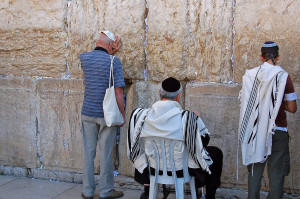In 19 B.C., Judea’s King Herod began building a trapezoidal-shaped retaining wall around the plateau on which Jerusalem’s Second Temple stood. Workers filled in the voids, creating a 37-acre paved platform. Herod expanded the Temple located near the western wall of this “Temple Mount.” Each Yom Kippur, the High Priest entered the Temple’s Holy of Holies, experiencing the presence of God.
In 70 A.D., during the First Jewish Revolt, Roman soldiers demolished Herod’s Temple. Rabbis advised Jews to shun the Temple Mount to avoid inadvertently encountering the area of the Holy of Holies, so they began praying at the “Western Wall” below. After the Second Jewish Revolt in 135, the Roman Empire banned Jews from Jerusalem. In about 325, Emperor Constantine allowed Jews to lament the loss of their Temple once each year at the Western Wall, which Christian residents disparagingly called the Jews’ “Wailing Wall.” In 1560, Ottoman Emperor Suleiman allowed Jews to pray at a section of the Western Wall near houses in the Moroccan Quarter.
In the 1948 war following Israel’s independence, Jordan captured East Jerusalem, including the Temple Mount, and barred Jews from the Western Wall. In 1967, Israel gained control of East Jerusalem and razed the Moroccan Quarter, creating a plaza along a section of theWestern Wall. A screen now divides the plaza so men and women can pray separately, many by inserting slips of paper between the wall’s massive blocks. Some pray for rebuilding the Jewish Temple on the site above them, now occupied by the Al Aksa Mosque, the third holiest place on earth for Muslims. How even God can resolve these conflicting claims is not clear.

Comments are closed.